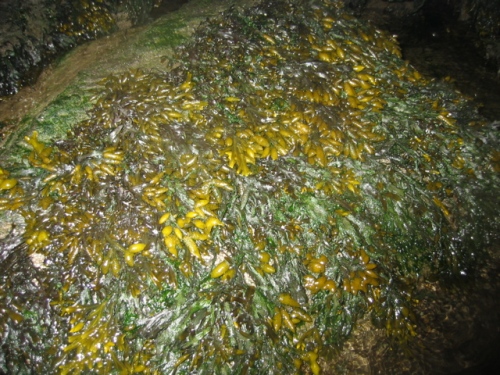By Erik Baard
One one the many torments my “poor, sainted mother” (as she calls herself) endured from me was a screamingly Pavlovian response to the jingle of the ice cream truck as it rumbled down 159th Street in Flushing, Queens, where I was raised. Little did I know then how intimately my love of the sweet dessert, the salty harbor, and my maternal heritage were bound.
A very common, yet fascinating, plant growing in our estuary is bladderwrack seaweed, scientifically known as fucus vesiculosus. Just a few of its other common names are popweed, black tang, rockweed, bladder fucus, seawrack, sea oak, black tany, cut weed, and rock wrack. I snapped the above picture of a healthy mat of its bubble form on riprap rock fringing Roosevelt Island (click to enlarge).
Bladderwrack is quite widespread in sheltered bays and inlets in the northern hemisphere, and has ancient pedigree. It’s a close relative of the first plants to colonize land. Of course the distinctive feature of this species is its air sacks, which lift fronds toward the surface, an evolutionary edge in the competition for sunlight for photosynthesis. Today beds of bladderwrack shelter young fish and crustaceans, and stabilizes intertidal sediment by slowing water movement.
You might not realize it, but there’s a very good chance you’ve eaten bladderwrack. Ice cream is one of the most common food products to include bladderwrack seaweed. Mass market foods often list it in the ingredients as simply “kelp” or note the chemicals derived from it, especially carrageenan. That thickening agent is named for the organism from which it was first extracted, Irish moss, known in Irish as carraig.
Iodine, beta carotene, and potassium are also refined from bladderwrack, though less often in recent years, and this seaweed has traditionally been used to treat thyroid illnesses and (with less solid evidence) obesity. Recent research also points to applications fighting estrogen-dependent diseases like breast cancer.
While people with certain medical conditions can suffer complications from consuming too many concentrated supplements made from bladderwrack, in Japan the plant is enjoyed as a popular food in its natural state. Sadly, there could be a pollution danger from eating bladderwrack growing in our harbor (as excited as we are about the estuary’s ongoing ecological recovery). Please consult the Department of Health and Department of Environmental Protection (dial 311) regarding any culinary experimentation.
Asian cultures are known for seaweed cuisine, but for thousands of years the Irish have eaten dulaman and dyed fabrics with it.
I can easily picture that kind of trade in a place like my maternal ancestral home of Sligo, Ireland. One of Ireland’s most popular traditional songs, about a monger of edible seaweed marrying (perhaps threatening to elope with) a seaweed dye monger’s daughter, makes that fancy all the more vivid. An interesting note on the lyrics is that in Irish, or Gaeilge, the gatherers and sellers of seaweed were addressed by the same noun as the product itself. That lends itself to some playful word-painting, comparing the fair hair and dark cap and black shoes of the suitor (or rogue?) to the top and base of the plant.
Dulaman
A ‘níon mhín ó, sin anall na fir shúirí
Oh gentle daughter, here come the wooing men
A mháithairin mhín ó, cuir na roithléan go dtí mé
Oh gentle mother, put the wheels in motion for meCurfá: Chorus:
Dúlamán na binne buí, dúlamán Gaelach
Seaweed from the yellow cliff, Irish seaweed
Dúlamán na farraige, b’fhearr a bhí in Éirinn
Seaweed from the ocean, the best in all of Ireland
Tá ceann buí óir ar an dúlamán gaelach
There is a yellow gold head on the Gaelic seaweed
Tá dhá chluais mhaol ar an dúlamán maorach
There are two blunt ears on the stately seaweed
Bróga breaca dubha ar an dúlamán gaelach
The Irish seaweed has beautiful black shoes
Tá bearéad agus triús ar an dúlamán maorach
The stately seaweed has a beret and trousers(Curfá 2x) (Chorus 2x)
Góide a thug na tíre thú? arsa an dúlamán gaelach
“What are you doing here?” says the Irish seaweed
Ag súirí le do níon, arsa an dúlamán maorach
“At courting with your daughter,” says the stately seaweed
Rachaimid chun Niúir leis an dúlamán gaelach
I would go to Niúir with the Irish seaweed
Ceannóimid bróga daora ar an dúlamán maorach
“I would buy expensive shoes,” said the Irish seaweed(Curfá) (Chorus)
Ó chuir mé scéala chuici, go gceannóinn cíor dí
I spent time telling her the story that I would buy a comb for her
‘Sé’n scéal a chuir sí chugam, go raibh a ceann cíortha
The story she told back to me, that she is well-groomed(Curfá) (Chorus)
Cha bhfaigheann tú mo ‘níon, arsa an dúlamán gaelach
“Oh where are you taking my daughter?” says the Irish seaweed
Bheul, fuadóidh mé liom í, arsa an dúlamán maorach
“Well, I’d take her with me,” says the stately seaweed
Dúlamán na binne buí, dúlamán Gaelach
Seaweed from the yellow cliff, Irish seaweed(Curfá) (Chorus)
Dúlamán na binne buí, dúlamán Gaelach
Seaweed from the yellow cliff, Irish seaweed
Dúlamán na farraige, b’fhearr a bhí, b’fhearr a bhíSeaweed from the ocean, the best, the best
Dúlamán na binne buí, dúlamán Gaelach
Seaweed from the yellow cliff, Irish seaweed
Dúlamán na farraige, b’fhearr a bhí, b’fhearr a bhí
Seaweed from the ocean, the best, the bestB’fhearr a bhí in Éirinn
The best in all of Ireland
The song has enjoyed many modern interpretations:
And fan of the song even gives it the anime treatment.
I hope all Irish love their mothers as much as they love dulaman seaweed!
